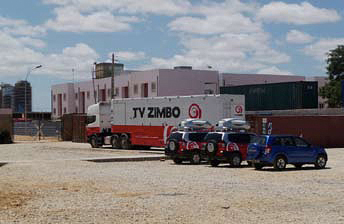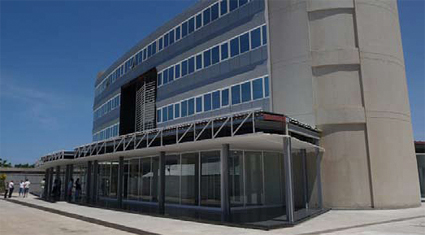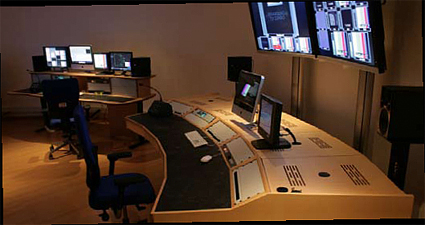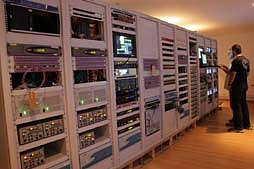Out Of Africa
For decades, Angola’s TV airwaves have been the sole property of Televisão Pública de Angola, the state-run broadcaster. But this monopoly was broken on December 14, 2008, with the launch of the country’s first privately owned broadcaster, TV Zimbo.

Broadcasting from a new low-rise headquarters building in the Angolan capital of Luanda, TV Zimbo is a joint venture between local group Medianova and Portugal’s TV1 channel. Its signal is available throughout the capital region, and via satellite on the MultiChoice Africa package.
Getting TV Zimbo to air was the job of UK system integrator VSC Design. The company was hired to do the entire production facility, from production designs to equipment selection, acquisition and integration, to putting the complex through initial testing and actual on-air launch.
“TV Zimbo was looking for someone to put their facility together in a very short timescale,” says Martyn Hales, VSC Design’s Managing Director. “The project started in June 2008, and the station went on air just six months later.”
A Difficult Environment
Having suffered through decades of civil war that only ended in 2002, Angola is still in the process of rebuilding its economy. The good news is that this sub-Saharan country is now a major oil producer, giving it the revenues it needs to prosper. The bad news is that transportation systems and electricity supply are still substandard; making the task of shipping in broadcast equipment and then powering it extremely difficult.

“It could take three to six weeks to bring in equipment from Britain to Luanda by ship, train, and truck,” says Hales.
Meanwhile, the state of the power grid in Angola required the team to put in generators to run TV Zimbo’s operations. “These generators and the station’s General Electric 75kVAx UPS ES are not for emergencies.,” says Hales, “They are used constantly to power the facility’s broadcast plant, computers, lighting, and air conditioning.”
From VSC Design’s perspective, the key to succeeding with the TV Zimbo installation lay in rigorous planning, with every element checked and rechecked through the process. “We knew that if we forgot to ship something from our UK office to Luanda, we couldn’t just pop down to the shop and buy it in Angola,” he says.
To get TV Zimbo to air on schedule, VSC had to design and then prebuild two news studios, four high-end editing suites, a fully-MOS integrated newsroom, and a Master Control to tie them all together.
“We put as much together as we could in the UK – down to installing equipment in the racks and wiring them – then took it apart in sections and shipped it down to Luanda,” says Hales. All of the wiring, the testing, and anything else that was required, was done at VSC Design’s London base first. “This way, the reassembly process had as little room for error as was humanly possible,” says Hales. Ten VSC Design staff were also dispatched Angola to reassemble the equipment.

Studios
At just 57.15 square metres each, both of TV Zimbo’s news studios are relatively small. One is equipped with a For-A/Brainstorm Multimedia digiStorm virtual set system used for newscasts. The second studio has a hard set, for interviews and on-air demonstrations.
“Each of the studios is equipped with three Sony DXCD55WSPH SD studio cameras, which are all manned,” Hales says. “They are fitted with BDL Autoscript teleprompters, while the intercom system is a Clearcom Eclipse PICO.”
The Studio galleries are each fitted with For-A Hanabi HVS-1500HS Vision Mixers, Harris Zandar Predator II multiviewers, NEC Multeos 46 inch 1920x1080 LCD displays (even though the station operates in SD), and Harris Inscriber character generators running GoTV InfoStudio. Ingest and playout are handled using an Apple XSAN running a Building4Media Fork Production System, which also manages TV Zimbo’s video production and media asset management.
Continuity and channel branding is done by a Miranda IS750 running under automated control but with a press control panel for manual override.
All of TV Zimbo’s news editing is done on four Apple Mac Pros running Final Cut Studio. Graphics are created using an Apple Mac Pro running Adobe After effects, or Windows PCs running GoTV.

Studio audio is produced using a Tascam DM-3200 mixer and Pro Tools HD audio editing systems. Signals are moved through the plant via an Nvision Axon FR5128-AX routing system. TV Zimbo’s newsroom runs on the ENPS system, which is tied into Master Control. Out in the field, the station has six SNG trucks.
Despite the tight timeline and difficult working environment, VSC Design was able to meet TV Zimbo’s delivery schedule. “Actually, it went better than expected,” says Mar tyn Hales. “We did have problems with power outages in the early days on site, until we had our own generators and UPS ES running. But we managed to get parts there more or less as we expected, and our people in Luanda did a great job of putting it all back together.”
According to Director General of TV Zimbo, Jose Silva, this project was always going to be tough due to the location. Fortunately, Silva adds, the VSC team was on hand to guide them at every step of the way. “VSC guided and advised us with all aspects of the build, even helping with production during the launch.”
“Despite the obstacles, we have enjoyed working in Angola, and hope to do more work in Africa,” Hales concludes. “Certainly we now know what we’re dealing with, in building TV facilities in this region.”
TV Zimbo’s New Addition
Having finished the original studio complex for TV Zimbo, VSC Design’s next task was to build a much larger studio for producing drama and musical programmes. Known as ‘Studio 3’, it is a 712 square metre, six camera SD production facility.
“The studio is used for making both pre-recorded shows, and for live programming via the playout centre built by VSC in 2008,” says Martyn Hales. “The shows produced in the studio include Who Wants To Be a Millionaire?, a topical chat and live music show Zimbando, and a daily entertainment show Sexto Sentido.
Studio 3 is equipped with Sony DXC cameras with Canon lenses, and a movie engineering camera jib. Its Master Control has a Sony DVS-9000 Vision mixer, Sony LMD monitors and NEC large size LCD monitors, Harris Inscriber running GoTV graphics software, Pro-Bel Pyxis SD Router with Axon modular distribution, Harris Predator multi-viewer with a TSL UMD control system, and Tektronix waveform monitoring. Audio is handled using a Soundcraft Vi4 audio mixing console, Sennheiser radio mics and Sennheiser in-ear monitoring. Studio 3 also has a Clearcom Eclipse talkback system with wireless Cellcom DECT units.
The professional video industry's #1 source for news, trends and product and tech information. Sign up below.
James Careless is an award-winning journalist who has written for TV Technology since the 1990s. He has covered HDTV from the days of the six competing HDTV formats that led to the 1993 Grand Alliance, and onwards through ATSC 3.0 and OTT. He also writes for Radio World, along with other publications in aerospace, defense, public safety, streaming media, plus the amusement park industry for something different.

